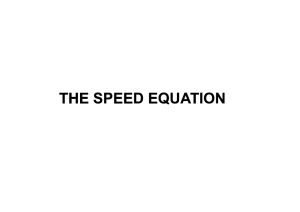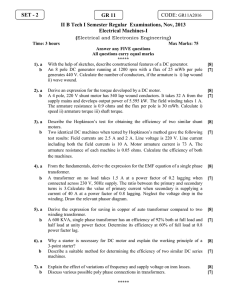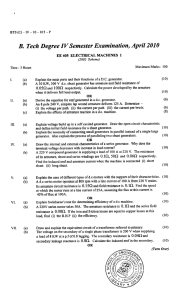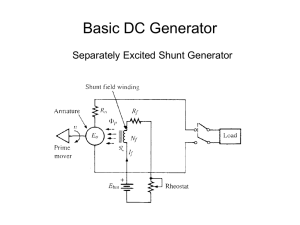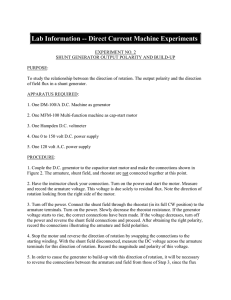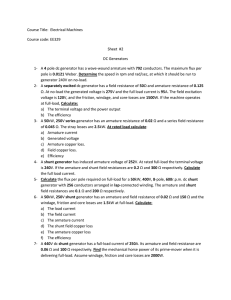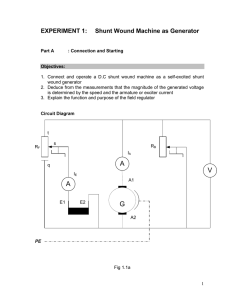electrical machines-i
advertisement
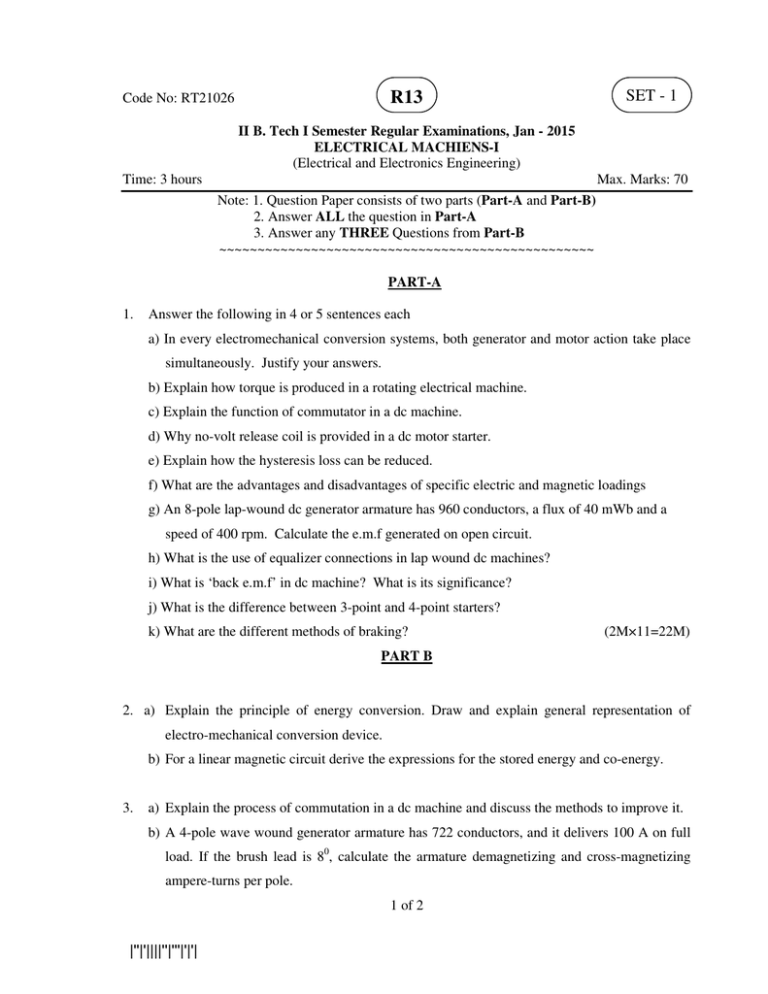
R13 Code No: RT21026 SET - 1 II B. Tech I Semester Regular Examinations, Jan - 2015 ELECTRICAL MACHIENS-I (Electrical and Electronics Engineering) Time: 3 hours Max. Marks: 70 Note: 1. Question Paper consists of two parts (Part-A and Part-B) 2. Answer ALL the question in Part-A 3. Answer any THREE Questions from Part-B ~~~~~~~~~~~~~~~~~~~~~~~~~~~~~~~~~~~~~~~~~~~~~~~~~ PART-A 1. Answer the following in 4 or 5 sentences each a) In every electromechanical conversion systems, both generator and motor action take place simultaneously. Justify your answers. b) Explain how torque is produced in a rotating electrical machine. c) Explain the function of commutator in a dc machine. d) Why no-volt release coil is provided in a dc motor starter. e) Explain how the hysteresis loss can be reduced. f) What are the advantages and disadvantages of specific electric and magnetic loadings g) An 8-pole lap-wound dc generator armature has 960 conductors, a flux of 40 mWb and a speed of 400 rpm. Calculate the e.m.f generated on open circuit. h) What is the use of equalizer connections in lap wound dc machines? i) What is ‘back e.m.f’ in dc machine? What is its significance? j) What is the difference between 3-point and 4-point starters? k) What are the different methods of braking? (2M×11=22M) PART B 2. a) Explain the principle of energy conversion. Draw and explain general representation of electro-mechanical conversion device. b) For a linear magnetic circuit derive the expressions for the stored energy and co-energy. 3. a) Explain the process of commutation in a dc machine and discuss the methods to improve it. b) A 4-pole wave wound generator armature has 722 conductors, and it delivers 100 A on full load. If the brush lead is 80, calculate the armature demagnetizing and cross-magnetizing ampere-turns per pole. 1 of 2 |''|'||||''|'''|'|'| Code No: RT21026 R13 SET - 1 4. a) Draw and explain the no-load and load characteristics of shunt, series and compound generators. Give the applications of different types of dc generators with reasons and justification b) A 10 kW, 250V dc shunt generator has total no load rotational loss of 400W. The armature circuit including brushes and shunt field resistance are 0.5 and 250 ohms respectively. Calculate the shaft power input and the efficiency at rated load. Also calculate the maximum efficiency and the corresponding power output. 5. a) What are the drawbacks of three point starters? Describe a four-point starter with a neat sketch. b) A 250V, 4-pole, shunt motor has two-circuit armature winding with 500 conductors. The armature circuit resistance is 0.25 ohms, field resistance is 100 ohms and the flux per pole is 0.03Wb. If the motor draws 14.5A from the mains, compute the speed and the internal (gross) torque developed. Neglect armature reaction. 6. a) What is meant by braking of dc motors? Briefly describe various methods of braking of dc shunt motors. b) A 500V shunt motor runs at its normal speed of 250 rpm when the armature current is 200A and resistance of armature is 0.12 ohms. Calculate the speed when a resistance is inserted in the field, reducing the shunt field to 80% of normal value, and the armature current is 100A. 7. a) What factors need to be considered for choice of ampere conductors in dc machines? b) List advantages and disadvantages of higher number of poles in dc machine. 2 of 2 |''|'||||''|'''|'|'| SET - 2 R13 Code No: RT21026 II B. Tech I Semester Regular Examinations, Jan - 2015 ELECTRICAL MACHIENS-I (Electrical and Electronics Engineering) Time: 3 hours Max. Marks: 70 Note: 1. Question Paper consists of two parts (Part-A and Part-B) 2. Answer ALL the question in Part-A 3. Answer any THREE Questions from Part-B ~~~~~~~~~~~~~~~~~~~~~~~~~~~~~~~~~~~~~~~~~~~~~~~~~ PART-A 1. Answer the following in 4 or 5 sentences each a) Write the energy balance equation and explain each term. b) What is meant by reactance voltage and how it will be neutralized? c) Give the reasons for failure of self excited generator to build up. d) What is the necessity of a starter for dc motor? e) What is the disadvantage of Swinburne’s test? f) What is resistance commutation? g) A series generator delivers a current of 100A at 250V. Its armature and field resistances are 0.1 ohm and 0.55 ohm respectively. Find (i) armature current (ii) generated e.m.f h) What are the causes of sparking in dc machines? i) Differentiate between the generator action and motor action of a dc machine? j) Explain the causes of hysteresis and eddy current losses in electric machines. On what factors do these losses depend? k) What are commutating poles? Why are they used? (2M×11=22M) PART B 2. a) Explain the term ‘co-energy’ in electromechanical energy conversion and show that coenergy is given by: Wf = 1/2 PF2 where P = permeance of the magnetic circuit and F = mmf in coil of magnetic circuit. b) Discuss singly and multiply excited magnetic field systems. 1 of 2 |''|'||||''|'''|'|'| Code No: RT21026 3. SET - 2 R13 a) Explain the function of interpoles in the generators with neat diagrams. b) A four pole, 23.75 kW, 250V lap wound dc shunt generator has 50 slots with 8 conductors per slot and shunt field resistance of 50Ω. The brushes are given a lead of 80 (mech) when the generator delivers full load current. Calculate the number of turns on the compensating winding if the pole arc to pole pitch ratio is 0.8. 4. a) Explain various power stages in a DC generator and also derive the condition for maximum efficiency b) A 10 kW, 250V DC, 6 pole shunt generator runs at 1000 rpm when delivering full load. The armature has 534 lap connected conductors. Full load copper loss is 0.64 kW. The total brush drop is 1V. Determine the flux per pole. Neglect shunt current. 5. a) Plot the speed-torque characteristics of different types of dc motors. Based on these characteristics specify the applications of dc motors. b) A 230V dc shunt generator has armature and field resistances of 0.06 ohms and 100 ohms respectively. Determine the total armature power developed when working (i) as generator delivering 25 kW output and (ii) as a motor taking 25 kW input. 6. a) What are the different types of speed control methods for dc motors? Discuss merits and demerits of each method. b) The Hopkinson’s test on two shunt machines gave for full load the following results: Line voltage = 250V, Line current excluding field currents = 50A, Motor armature current = 380A, Field currents = 5A and 4.2A. The armature resistance of each machine is 0.02 ohm. Calculate efficiency of each machine. 7. a) On what factors does the length of the air gap in dc machines depend? Explain. b) Find an expression of minimum number of coils required in armature winding such that the maximum voltage between consecutive segments does not exceed beyond 30V. 2 of 2 |''|'||||''|'''|'|'| SET - 3 R13 Code No: RT21026 II B. Tech I Semester Regular Examinations, Jan - 2015 ELECTRICAL MACHIENS-I (Electrical and Electronics Engineering) Time: 3 hours Max. Marks: 70 Note: 1. Question Paper consists of two parts (Part-A and Part-B) 2. Answer ALL the question in Part-A 3. Answer any THREE Questions from Part-B ~~~~~~~~~~~~~~~~~~~~~~~~~~~~~~~~~~~~~~~~~~~~~~~~~ PART-A 1. Answer the following in 4 or 5 sentences each a) Give the examples of singly excited and doubly excited electro mechanical energy devices and also write the energy equations. b) What is back e.m.f in dc machine? What is its significance? c) Differentiate between Lap and Wave windings in dc machines and mention the relative merits and demerits. d) An 8-pole wave connected dc generator has 1000 armature conductors and flux/pole is 0.035Wb. At what speed it must be driven to generate 500V on open circuit. e) What is the need of testing dc machine and what are the different tests to be conducted on different machines f) What are the advantages and disadvantages of specific electric and magnetic loadings? g) The shunt field winding has high resistance while series field has a low resistance. Why? h) In what type of dc machine wave winding is employed and why? i) Explain the term commutation period? j) Explain how torque is produced in a rotating electrical machine. k) What are interpoles? Why are they used? (2M×11=22M) PART B 2. a) For a singly-excited magnetic system, derive the relation for the magnetic stored energy in terms of reluctance. b) Determine the necessary expressions for determining the force and torque in multi excited magnetic field system. 1 of 2 |''|'||||''|'''|'|'| 3. SET - 3 R13 Code No: RT21026 a) What is meant by commutation? Explain how spark-less commutation is obtained in a dc generator, with neat diagrams. b) A 4 pole 40 kW, 200V wave wound shunt generator has 420 conductors. Brushes are given a lead of 5 commentator segments. Calculate the demagnetizing amp-turns per pole if shunt field resistance is 40 ohm. Also calculate extra shunt field turns/pole to neutralize the demagnetization. 4. a) What is a compound generator? Differentiate between over, level and differential compounding? Draw external characteristics for these generators? b) A DC shunt generator running at 1000 r.p.m gave the following O.C.C. Field current (Amps): 1 EMFs (Volts): 2 52.5 107.5 3 4 155 196.5 5 6 7 231 256.5 275 8 287.5 Calculate the voltage to which the machine will build up if the speed is 800 r.p.m and the field circuit resistance is 30 ohms. 5. a) Explain the working principle of a 3 point starter of a dc shunt motor with neat diagram. b) A 440V shunt motor takes 105A (Armature current) from the supply and runs at 1000 r.p.m. Its armature resistance is 0.15 ohm. If the total torque developed is unchanged, calculate the speed and armature current if the magnetic field is reduced to 70% of the initial value. 6. a) Explain Retardation test with a neat diagram. b) The armature and shunt field resistances of a 500V shunt motor are 0.2 ohm and 100 ohms respectively. Fine the resistance of the shunt field regulator to increase the speed from 800 r.p.m to 1000 r.p.m, if the current taken by the motor is 450A. The magnetization characteristics may be assumed as straight line. 7. a) Derive the expression for output equation of a dc machine. b) List the factors to be considered for selecting the number of armature slots 2 of 2 |''|'||||''|'''|'|'| SET - 4 R13 Code No: RT21026 II B. Tech I Semester Regular Examinations, Jan - 2015 ELECTRICAL MACHIENS-I (Electrical and Electronics Engineering) Time: 3 hours Max. Marks: 70 Note: 1. Question Paper consists of two parts (Part-A and Part-B) 2. Answer ALL the question in Part-A 3. Answer any THREE Questions from Part-B ~~~~~~~~~~~~~~~~~~~~~~~~~~~~~~~~~~~~~~~~~~~~~~~~~ PART-A 1. Answer the following in 4 or 5 sentences each a) Define field energy and co-energy? b) What is meant by reactance voltage? c) Prove that speed control characteristic of a dc shunt motor by flux control method is hyperbola. d) What are commutating poles? Why are they used? e) What is the need of testing dc machine and what are the different tests to be conducted on different machines f) What are the advantages and disadvantages of specific electric and magnetic loadings g) What purpose is served by brushes in a dc machine? h) Why are field coils provided in a dc generator? i) How are interpoles excited? j) What is the significance of back e.m.f in dc machine? k) Explain how the eddy current loss can be reduced. (2M×11=22M) PART B 2. a) Prove that the energy and co-energy in a linear magnetic system are given by identical expressions. b) Determine the necessary expressions for determining the force and torque in multi excited magnetic field system. 1 of 2 |''|'||||''|'''|'|'| 3. SET - 4 R13 Code No: RT21026 a) Explain the action of compensating windings used in dc machines. Show schematically how they are interconnected? b) A 4 pole wave connected generator supplied 134 A. It has 492 armature conductors. When delivering full load the brushes are given an actual lead of 100. Calculate the demagnetizing ampere turns per pole. The shunt field winding takes 10A. Find extra shunt field turns necessary to neutralize this demagnetization. 4. a) With the help of suitable diagrams explain different methods of excitation of dc generators? b) The open circuit characteristic of a separately exited generator at 600 r.p.m is as under: Field current (Amps): 1.6 3.2 EMFs (Volts): 285 390 460 520 560 590 148 4.8 6.4 8.0 9.6 11.2 Find (i) The voltage to which the machine will excide as a shunt generator with a field circuit resistance of 60 ohm (ii) Critical resistance at this speed. 5. a) Explain speed-current, torque-current and speed-torque characteristics of a dc series motor. b) Why is starting current high in a dc motor? Explain the working of a four-point starter for a dc machine. 6. a) Explain “Hopkinson’s” test. Why it is called a regenerative test? b) A 220V DC shunt motor draws a no-load current of 2.5A when running at 1400 r.p.m. Determine its speed when taking an armature current of 60A, if armature reaction weakens the flux by 3%. 7. a) On what factors does the length of the air gap in dc machines depend? Explain. b) Find an expression of minimum number of coils required in armature winding such that the maximum voltage between consecutive segments does not exceed beyond 30V. 2 of 2 |''|'||||''|'''|'|'|
